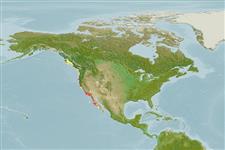>
Eupercaria/misc (Various families in series Eupercaria) >
Sciaenidae (Drums or croakers)
Etymology: Seriphus: Greek, seriphos, -ou, serphos = a mosquito or winged ant (Ref. 45335).
More on author: Ayres.
Environment: milieu / climate zone / depth range / distribution range
Ecología
marino demersal; rango de profundidad 1 - 21 m (Ref. 2850), usually 1 - 8 m (Ref. 2850). Subtropical; 54°N - 23°N, 133°W - 109°W
Eastern Pacific: Yaquina Bay in Oregon, USA to southern Baja California, Mexico. Recorded from British Columbia, Canada (Ref. 11980).
Length at first maturity / Tamaño / Peso / Age
Maturity: Lm 10.3, range 10 - 10.5 cm
Max length : 30.0 cm TL macho / no sexado; (Ref. 2850)
Occur inshore, often over sandy bottoms. Common in bays and tidal sloughs, around pilings. Moves to deeper water at night (Ref. 9118). Form schools. Feed on small shrimps, marine worms and fishes (Ref. 9118). Pelagic spawners (Ref. 56049).
Mean interval between spawnings is about 7.4 days (Refs. 51164, 51165).
Eschmeyer, W.N., E.S. Herald and H. Hammann, 1983. A field guide to Pacific coast fishes of North America. Boston (MA, USA): Houghton Mifflin Company. xii+336 p. (Ref. 2850)
IUCN Red List Status (Ref. 130435)
Threat to humans
Harmless
Human uses
Pesquerías: escaso valor comercial; carnada: usually
Más información
Age/SizeCrecimientoLength-weightLength-lengthLength-frequenciesMorfometríaMorfologíaLarvaDinámica larvariaReclutamientoAbundanciaBRUVS
ReferenciasAcuiculturaPerfil de acuiculturaRazasGenéticaElectrophoresesheritabilidadEnfermedadesProcesamientoNutrientsMass conversion
Herramientas
Special reports
Download XML
Fuentes de Internet
Estimates based on models
Preferred temperature (Ref.
123201): 9.6 - 18.6, mean 11 °C (based on 159 cells).
Phylogenetic diversity index (Ref.
82804): PD
50 = 1.0000 [Uniqueness, from 0.5 = low to 2.0 = high].
Bayesian length-weight: a=0.00575 (0.00278 - 0.01190), b=3.11 (2.93 - 3.29), in cm total length, based on LWR estimates for this (Sub)family-body shape (Ref.
93245).
Nivel trófico (Ref.
69278): 3.7 ±0.57 se; based on food items.
Generation time: 5.5 ( na - na) years. Estimated as median ln(3)/K based on 2
growth studies.
Resiliencia (Ref.
120179): Medio, población duplicada en un tiempo mínimo de 1.4-4.4 años (tm=2; Annual fecundity = 300,000).
Fishing Vulnerability (Ref.
59153): Moderate vulnerability (39 of 100).
